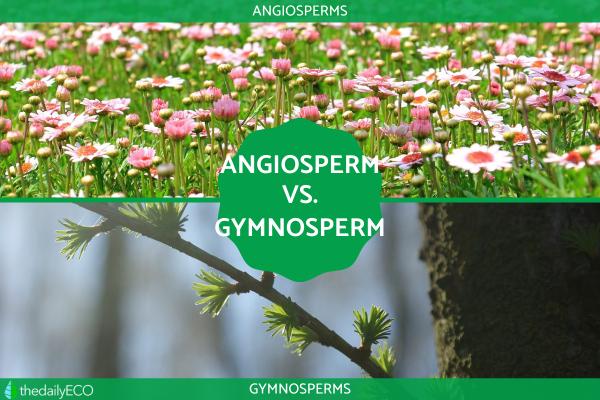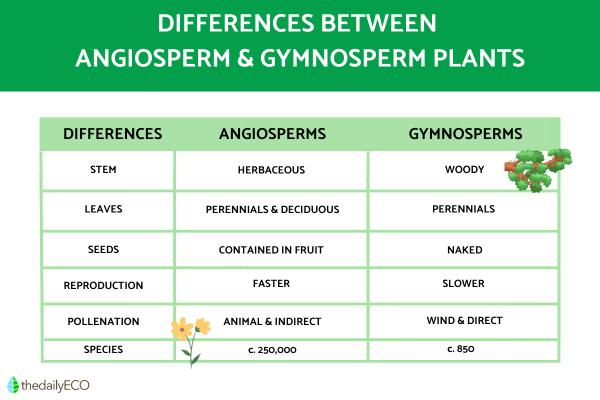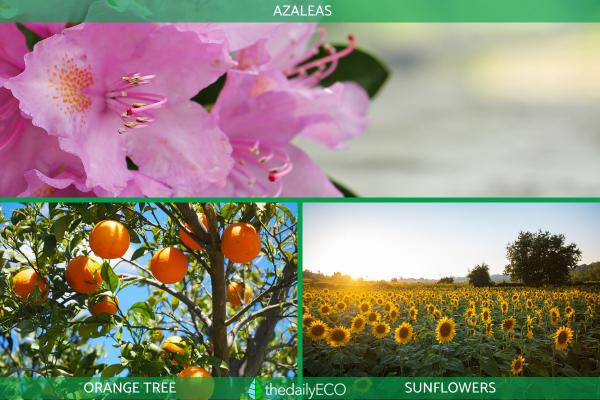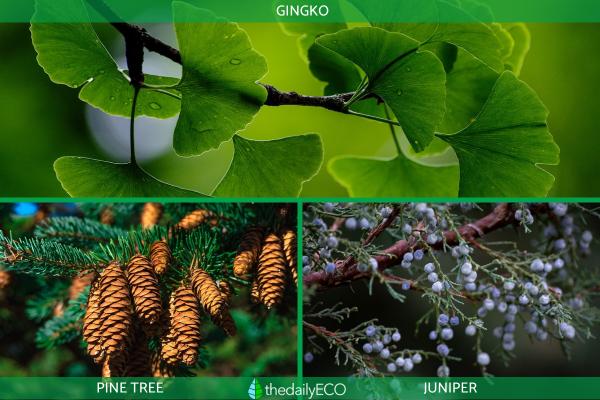The Difference Between Angiosperm and Gymnosperm Plants


The main difference between angiosperms and gymnosperms is related to their ability to flower. Although they share many similarities, their differences are vitally important to their ecosystems. Not all types of plant can grow in the same ecosystem, with gymnosperms and angiosperms better adapted to certain environments. This doesn't mean these types of plant don't necessarily grow in the same ecosystems. Their species specifications also play an important part. An ability to flower may be one of the defining differences between gymnosperms and angiosperms, but it is far from the only one.
At thedailyECO, we explore the differences between angiosperm and gymnosperm plants. We do so by making a comparison of gymnosperms vs. angiosperms, as well as looking at definitions and examples of them individually.
Summary of the differences between angiosperm and gymnosperm plants
The Kingdom Plantae contains all living organisms that are not part of the other kingdoms of nature such as animals and fungi. For this reason, the diversity of plants is staggering. Categorizing plants allows us to better understand them individually and the roles they have within ecosystems. One of the most diverse and important categories is the group Embryophyta, commonly known as land plants, i.e. the plants that grow on land.
Angiosperms and gymnosperms are both in this group, but they have some key differences which set them apart. The differences between gymnosperms vs. angiosperms include:
- Plants that belong to the group gymnosperms are usually woody, while angiosperms are mostly herbaceous.
- The branching of gymnosperms is always of monopodic (grows upward from a single point), while in angiosperms it is sympodic (one branch develops more strongly than the other).
- In the case of gymnosperms we speak of a taproot system with superficial roots, while in angiosperms they have a branched-root system without a main axis.
- The trunk of gymnosperms is formed only by tracheids, in the case of angiosperms it is composed of both tracheids and tracheas.
- Gymnosperms have evergreen leaves. Cngiosperms can be both deciduous and evergreen.
- Pollination of gymnosperms is anemophilous (wind distributed) and direct. This means that the pollen is directly captured by the ovule. In angiosperms, pollination is zoophilic (distributed by animals) and indirect, so the pollen is captured by the stigma.
- Fertilization of gymnosperms is simple and that of angiosperms is double.
- The seeds of gymnosperms are naked and can have numerous cotyledons, while angiosperm seeds have only 1 or 2 cotyledons and are found inside the fruit.
- The reproduction of gymnosperms is much slower than that of angiosperms.
- There are more than 250,000 species within the group of angiosperms while gymnosperms only have approximately 850 different species.
We will continue our comparison of angiosperms vs. gymnosperms in the sections below by looking at them individually with examples.

What are angiosperm plants?
Angiosperm plants make up the largest group of land plants with more than 250,000 specimens. Angiosperms are cormophytes, meaning they are plants with differentiated tissues and organs that are mainly characterized by having the so-called true flowers. This is where their seeds are located. In addition, these have what is known as a pedicel, a small leaf born in the axillary area of the bract.
In the case of angiosperm plants, the seeds remain enclosed and protected by the carpels or the wall of the ovary until it is pollinated and becomes a fruit. Within this classification we will not only find herbaceous plants, but also shrubs and trees. They are further classified into two groups known as monocotyledons and dicotyledons due to the number of cotyledons of their seeds (one and two, respectively).
Dicots
Dicotyledon angiosperm plants are those whose seeds are provided with two cotyledons located on each side of the embryo. Cotyledons are embryonic leaves which become the first leaves to develop after germination. The main root of these plants is very resistant and remains until the end of the plant's life.
As for the stem, dicotyledonous plants have vessels arranged in circles. These woody and fibrous stems have a tissue called cambium between the vessels. The function of this is to help the growth and thickness of the stem.
Monocots
Monocotyledon angiosperms are those that are distinguished by having a complete and visible flower. In addition, it has a single cotyledon which completely envelops the seed. The roots of this type of plants are of the fasciculated type, meaning they are clustered in a bundle. Unlike in dicotyledons, the stem is not usually branched, so they do not have a cambium. In the case of herbaceous plants, the stem is hollow. Their flowers usually appear almost always in multiples of three.
Discover more about flowering plants with our guide to the different types of carnations.
Examples of angiosperm plants
Here we give you several examples of angiosperm plants , which you will surely already know:
- Orange tree
- Poppy
- Wheat
- Geranium
- Apple tree
- Ginger
- Peach
- Rosebush
- Birch
- Sugar cane
- Banana
- Azalea
- Barley
- orchids
- Lily
- Clover
- Sunflower
- African daisies
- Vines
- Watermelon
- Cucumber
Discover more detail about some types of angiosperms with our guide to annual flowering plants.

What are gymnosperm plants?
Gymnosperms are seed plants, also known as spermatophyte plants. In these plants, both the ovules and the seeds are not found covered or enclosed. They are generally woody plants, such as trees and shrubs. Gymnosperm plants were the first seed plants to evolve
As for its leaves, they are usually simple, mainly small and acicular or needle-shaped. With few exceptions, the leaves of angiosperms are evergreen leaves. They are also known or more easily identified because they do not have true flowers.
In some species of angiosperms, the seeds have a wing to allow dispersal by the wind. This type of structure is known as a samara. Both pollination and fertilization are a slow process that can last for more than a year.
Learn more about this type of non-flowering plant with our guide to what are gymnosperms?
Examples of gymnosperm plants
As you can see with the following list, gymnosperm plants are usually trees which do not have flowers. However, there are also shrubs and some other types of plants which are considered to be gymnosperms. Examples include:
- Cedar
- Pine tree
- Cypress
- Redwoods
- Ginkgo
- Araucaria
- Sabina
- Pine tree
- Larch
- Fern
- Juniper
- Yew
- Tsuga
- Spruce
- Fir tree
- Araucaria
- Cycad
- Lleuque
Learn about another way of grouping and categorizing plants with our article on what are xerophyte plants?


If you want to read similar articles to The Difference Between Angiosperm and Gymnosperm Plants, we recommend you visit our Biology category.








